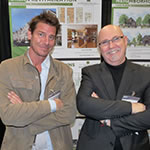A Web series starring Ty Pennington of Extreme Home Makeover and architect Mike Rosen is documenting the demolition of an outdated and inefficient house in Florida and the building of its replacement, an environmentally sensitive and technologically state-of-the-art green home. The project, called the First to the Future Home, is a collaboration between Rosen, NextGen Home TV, and Martin Architectural Group.
A pioneer in green building since the early 1980s and, until recently, the director of Martin Architectural Group’s Green Studio, Rosen has played a major role in the innovation and development of sustainable design and construction technologies for more than 30 years. Now the market leader of the Green Studio at BSB Design, Rosen will use his experience in the development of this 21st-century residence. The team is making full use of practices that were something of a hard sell 10 years ago but have become more standard today. The house also will serve as a showcase and pilot project for even newer technologies, some still in R&D.
The most basic elements of a sustainable home are a tight envelope and efficient systems. From the metal, Decra shingle roof down, the house goes far beyond what is required by Florida’s prescriptive building codes for energy efficiency. “This house is going to be off the charts,” Rosen says, “beyond the locally mandated regulations, simply because of the way it’s being put together and the systems we’re using.” The most obvious factors affecting home construction in Florida are sun and weather events—specifically, hurricanes. Rosen’s walls will be able to withstand windborne debris hitting them at 130 miles per hour, and his windows will withstand a two-by-four-foot projectile at 60 miles per hour. Solar panels will generate power. One particularly unique feature of the home is a band of SageGlass that runs the entire perimeter of the roof, where it meets the wall. The glass contains nanoparticles that can be manipulated by remote control, making the glass turn from transparent to completely opaque at the flick of a switch.
Other innovative features of the home include its use of iModules and a Corewall, both developed by Rosen and genuinely groundbreaking in the construction of not only single-family and multifamily homes, but also townhouses and high-rises. The iModule is a self-contained, stand-alone unit that can function singularly as a one-room house. In fact, one will be delivered to the site of First to the Future Home and be used as a dwelling there. As the house is being stick framed, modules will be added until the original studio becomes a two-story, five-bedroom home.
iModules also are low-cost, ready solutions for temporary, emergency housing, or could be “plopped in the backyard for a mother-in-law or returning student,” Rosen says.

This home’s walls can withstand hurricane debris hurtling at 130 miles per hour.
A Corewall is similarly self-contained but houses all of the home’s mechanical systems. The single-wall solution centralizes equipment and makes it easily accessible for maintenance or repair, or even complete replacement.
All of this has led to encouraging changes in the costs associated with building efficiently. “We’ve come a long way in terms of manufacturers putting products out there that are sustainable and green but don’t cost more,” Rosen says. “Five years ago, you had to pay a premium for low-VOC paint or carpet, but now they’re readily available and competitive, price-wise.” Other energy- and resource-saving features that have become virtually mainstream: low-flow toilets and LED bulbs.
But some sustainable features still come at a higher initial cost, especially renewable energy systems, whether wind, solar, or geothermal. Rosen urges homebuilders and buyers to consider the point at which that cost is recouped. He says the return on investment has become considerably more compelling within just the past few years. “Today’s energy costs are going to pay for the systems in as little as three years,” he says, “whereas it used to be seven to twelve.”
“Another thing that needs to happen,” he continues, “is that banks and appraisal organizations need to get on board. A net-zero house with utility bills that are extremely low, if not zero, is a credit that should be factored into purchase and resale.” Rosen says such an evolution in how the industry finances and appraises new homes would be a huge step forward.
“[This is] the argument I give my clients for sustainability,” Rosen says. “If your payback is so greatly reduced, why wouldn’t you build green?”

